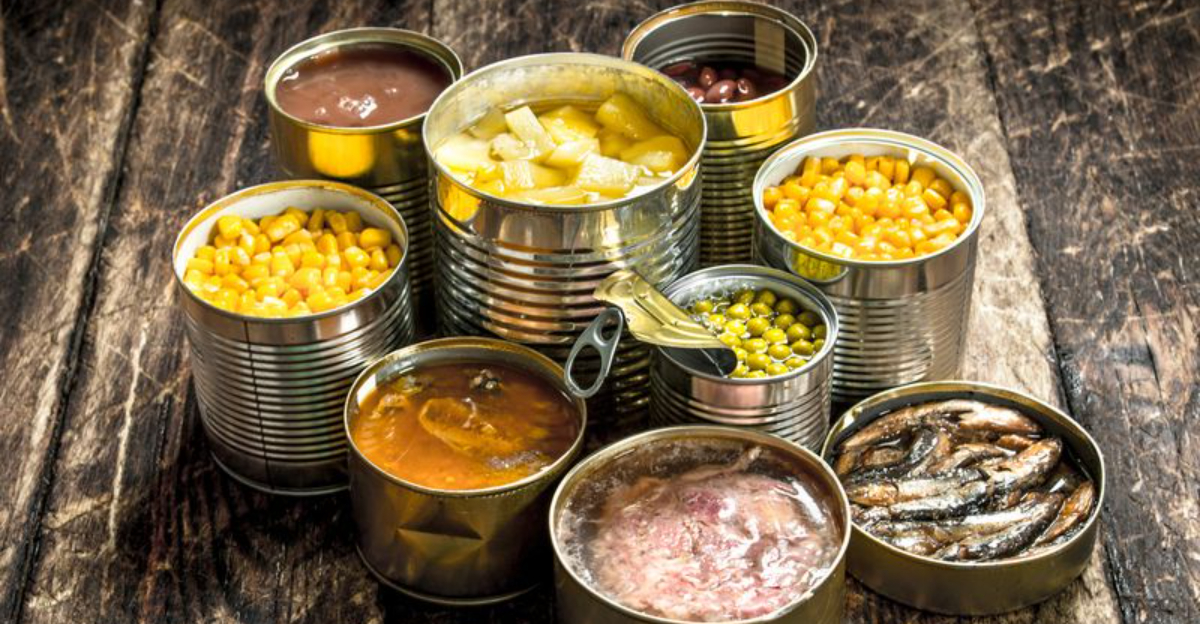12 Red Flags That Mean Your Canned Goods Have Gone Bad

Canned goods are pantry heroes, built to last and ready when you need them most. But even these shelf-stable staples have their limits.
One bad can might not just ruin dinner, it could spell trouble for your health.
From bulges and leaks to smells that scream “toss me,” knowing what to watch for can save you from a risky bite. A little awareness goes a long way when your food comes sealed in metal.
1. The Telltale Bulging Lid
Poking out like a drum skin stretched too tight, a bulging lid means serious trouble brewing inside. This dome-shaped deformity happens when bacteria create gases as they multiply in your canned goodies.
Never attempt to salvage these cans! The contents could harbor botulism, a potentially deadly toxin that has no taste or smell.
Even slight bulging deserves immediate disposal, no questions asked.
2. Swollen Can Body
Got a can that looks like it’s been hitting the gym? That puffy, expanded body is actually bacterial activity causing gas buildup inside. Once harmless contents are now potentially dangerous.
Remember my aunt’s story about the “pregnant” soup can that exploded when she touched it? That’s exactly what we’re talking about here.
Toss these swollen soldiers immediately, your stomach will thank you for the mercy.
3. Leaky Seam Situation
Moisture escaping from a can’s seams means the protective seal has failed its one job. Those tiny droplets or sticky residue around the edges aren’t just cosmetic issues. They’re welcome mats for bacteria.
Food safety experts agree this is non-negotiable territory. Once outside air has access to your canned goods, all bets are off regarding safety.
Consider these compromised containers immediate trash candidates, regardless of how tempting the contents might be.
4. Rust That Can’t Be Trusted
Rust spots aren’t just ugly. They’re tiny doorways allowing microbes to crash your food party. Those reddish-brown patches might seem innocent, but they signal the can’s structural integrity is compromised.
Light surface rust can sometimes be wiped away safely. However, if the rust has created pits, holes, or covers seam areas, consider that food condemned.
The metal barrier between your dinner and dangerous bacteria has been breached, making this a no-go situation.
5. Seam Dents Spell Danger
Bumped your grocery bag? That innocent-looking dent along the can’s seam might be more treacherous than you think.
While body dents are usually harmless, seam damage compromises the can’s airtight fortress. Picture the seam as the castle gate. Once breached, invaders (bacteria) can march right in.
Microscopic openings might not be visible to your eyes, but pathogens don’t need much space to infiltrate. When seams are compromised, it’s safer to sacrifice one can than risk your health.
6. Cracked Can Catastrophe
Spotting a crack in your can? That’s nature’s way of screaming “don’t eat me!” These fractures in the metal barrier provide a superhighway for bacteria to contaminate previously safe food.
Unlike minor dents, cracks aren’t a gray area in food safety. They’re a definite deal-breaker.
Even hairline fractures can allow microscopic organisms to enter and multiply, potentially causing serious foodborne illness. When metal integrity fails, your only safe option is immediate disposal.
7. Popped Seal Predicament
Jar lids should make that satisfying ‘pop’ when you first open them, not before! A home-canned jar with an already-popped button or a commercial can with a compromised vacuum seal spells trouble.
My grandmother taught me this trick: press the center of the lid before opening. If it moves up and down or feels springy, the vacuum seal has already failed.
This means air, and potentially harmful microorganisms, have found their way inside, making your preserved goodies a potential health hazard.
8. The Suspicious Hiss
Cans should open with a gentle whoosh, not a dramatic hiss like you’ve unleashed something from a science fiction movie.
That unexpected sound is pressurized gas escaping, created by microorganisms having a party inside.
Just last month, I opened a questionable can of beans that hissed loudly, and the smell that followed confirmed my suspicions.
Trust your senses here! That abnormal sound is basically your food screaming warnings at you. When in doubt, throw it out. No recipe is worth food poisoning.
9. Funky Smell Fiasco
Your nose knows! That sour, fermented, or just plain wrong odor wafting from your opened can isn’t your imagination. It’s a powerful warning system evolution gave us.
Even if everything else seems normal, an off smell means chemical changes have occurred inside. Bacteria produce distinctive odors as they multiply and break down food.
Remember when my brother ignored that fishy smell from his “perfectly good” canned tuna? Two days of stomach troubles later, he learned his lesson!
10. Color Change Caution
Canned peaches shouldn’t look brown, and green beans shouldn’t have a grayish tint. Unusual color changes signal chemical reactions or microbial growth that have altered your food’s composition.
While some color variation is normal (like slight darkening at the top of canned tomatoes), dramatic or uneven discoloration is your cue to abort mission.
My food safety instructor put it perfectly: “Nature color-codes danger for us, pay attention!” Those strange hues are essentially warning flags your food is waving frantically.
11. Mold: The Unwelcome Houseguest
Fuzzy patches in your canned goods are never a gourmet addition. Seeing mold means moisture and oxygen found their way inside… the perfect storm for spoilage.
Never scrape off mold and eat what’s underneath! Unlike with hard cheeses, mold in canned foods can produce invisible toxins throughout the entire product.
Those colorful spores might look almost artistic, but they’re actually nature’s “do not eat” sign. Even a tiny spot of mold means the entire contents should head straight to the trash.
12. Expired Date Dilemma
Finding a can from when flip phones were cool? That expiration date isn’t just a suggestion, it’s the manufacturer’s promise of safety and quality within that timeframe.
While high-acid foods like tomatoes typically last 12-18 months, low-acid options like green beans can be safe for 2-5 years when stored properly. But don’t push your luck!
The longer past expiration, the more risks you take with diminished nutritional value and potential safety issues. When in doubt, remember that a few dollars saved isn’t worth a stomach disaster.
